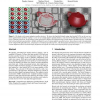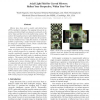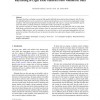108
Voted
TOG
2010
14 years 7 months ago
2010
We optimize automultiscopic displays built by stacking a pair of modified LCD panels. To date, such dual-stacked LCDs have used heuristic parallax barriers for view-dependent imag...
141
Voted
HVEI
2009
14 years 10 months ago
2009
The appearance of objects in scenes is determined by their shape, material properties and by the light field, and, in contradistinction, the appearance of those objects provides u...
111
Voted
GRAPHICSINTERFACE
2009
14 years 10 months ago
2009
We present an approach to convert a small portion of a light field with extracted depth information into a cinematic effect with simulated, smooth camera motion that exhibits a se...
119
Voted
CVPR
2010
IEEE
14 years 10 months ago
2010
IEEE
Mirrors have been used to enable wide field-of-view (FOV) catadioptric imaging. The mapping between the incoming and reflected light rays depends non-linearly on the mirror shape ...
120
Voted
CGF
2008
15 years 1 days ago
2008
The paper describes a technique to generate high-quality light field representations from volumetric data. We show how light field galleries can be created to give unexperienced a...
109
Voted
CG
2008
Springer
15 years 1 days ago
2008
Springer
We report on a multiresolution rendering system driving light field displays based on a specially arranged array of projectors and a holographic screen. The system gives multiple ...
100
Voted
TOG
2002
15 years 2 days ago
2002
We present a feature-based technique for morphing 3D objects represented by light fields. Our technique enables morphing of imagebased objects whose geometry and surface propertie...
112
Voted
CGF
1999
15 years 3 days ago
1999
Light fields and Lumigraphs are capable of rendering scenes of arbitrary geometrical or illumination complexity in real time. They are thus interesting ways of interacting with bo...
99
Voted
TOG
2008
15 years 10 days ago
2008
We describe a unified representation of occluders in light transport and photography using shield fields: the 4D attenuation function which acts on any light field incident on an ...
87
Voted
TOG
2008
15 years 10 days ago
2008
Glare arises due to multiple scattering of light inside the camera




